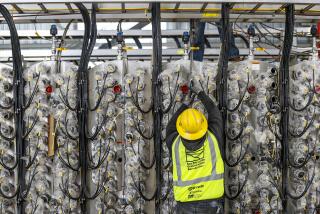DWP to build groundwater treatment plants on Superfund site
The Los Angeles Department of Water and Power plans to build the world’s largest groundwater treatment center over one of the largest Superfund pollution sites in the United States: the San Fernando Basin.
Two plants costing a combined $600 million to $800 million will restore groundwater pumping of drinking water from scores of San Fernando Valley wells that the DWP began closing in the 1980s, the utility said. The plants also will ensure that other wells remain open despite pollution plumes steadily migrating in their direction.
The plans mark a major shift at DWP, reversing a trend of recent decades in which the utility has offset diminishing use of groundwater with imports from Northern California and the eastern Sierra.
“By 2035, we plan to reduce our purchases of imported water by half,” said James McDaniel, the DWP’s senior assistant general manager.
The shift is necessary because environmental restrictions in the Sierra have reduced those imports and because the cost of water from the north has risen sharply — 84% over the last decade.
The San Fernando Basin accounts for more than 80% of the city’s total local water rights, but because of contamination plumes of toxic chemicals including hexavalent chromium, perchlorate, nitrates and the carcinogen trichloroethylene, only about half of its 115 groundwater production wells are usable.
At the current rate of migration of pollutants, the city would be unable to use most of its groundwater entitlements in the basin within five to seven years, forcing it to buy and import more expensive water from the Metropolitan Water District, DWP officials said.
One treatment center will be built on DWP property in North Hollywood just north of Vanowen Street, between Morella and Hinds avenues. It will process three times as much water per second as the world’s largest existing groundwater treatment facility, officials said. The DWP will build a second, slightly smaller center near the intersection of the 5 and 170 Freeways.
Construction is to begin in five years, said Marty Adams, director of water operations for the DWP. The DWP hopes to have both centers operating by 2022, producing about a quarter of the 215 billion gallons the city consumes each year.
The cost of the treatment centers will be largely borne by ratepayers, backed by municipal bond sales and spread out over 30 to 40 years, McDaniel said. The size of the rate increase for the project has yet to be determined, and the utility said it expects to field many questions from public officials and customers as the plans move forward.
Part of the cost will be offset by reducing demand for more expensive imported water and from financial compensation under the federal Superfund laws, which requires payments by parties responsible for contamination.
Over the last decade, local groundwater has provided about 11% of the city’s total supplies, and nearly 30% in drought years. About 36% came from the Los Angeles Aqueduct system in the eastern Sierra Nevada and 52% from Metropolitan Water District supplies pumped from Northern California.
This year, amid ongoing drought conditions, the Los Angeles Aqueduct system is conveying less water from the Sierra than at any time since it was built in 1913.
Environmental organizations welcomed news about the treatment plants.
“The key thing is that Los Angeles is looking ahead. With climate change, we can no longer rely on snow in the Sierra Nevada range to be our reservoir,” said Lenny Siegel, spokesman for the Center for Public Environmental Oversight.
Conner Everts, executive director of the Southern California Watershed Alliance, said environmental organizations have wanted to recharge the aquifer with more storm water and other sources “but DWP said it wasn’t possible because of the pollution.”
“It’s exciting that the DWP is finally moving forward with greater reliance on local water supplies,” Mark Gold, associate director of UCLA’s Institute of the Environment and Sustainability, said. “However, it’s long overdue. Could they have done this five years ago? Yes.”
The basin’s groundwater was contaminated primarily by improper storage and handling of chlorinated solvents, including trichloroethylene, also known as TCE, which was widely used after World War II to degrease metal and electronic parts. The solvents were dumped into disposal pits and storage tanks at industrial plants and military bases, where it seeped into the aquifer.
Other contaminants came from automobile repair shops and junkyards, unlined landfills, dry cleaners, paint shops, chrome plating businesses and historic dairy and agricultural operations.
The EPA determined in 2011 that TCE can cause kidney and liver cancer, lymphoma and other health problems.
The public can be exposed to TCE in several ways, including by showering in contaminated water and by breathing air in homes where TCE vapors have intruded from the soil. TCE’s movement from contaminated groundwater and soil into the indoor air of overlying buildings is a major concern.
The DWP is currently drilling monitoring wells throughout the region to identify as many contaminants as possible and develop strategies for removing them, said Susan Rowghani, director of DWP’s water engineering and technical services. Each contaminant will require its own specialized purification process.
For example, the current process for removing TCE is to pump water to the top of an aeration tower and, as the water flows back down, use an upward blower to send a countercurrent through it. TCE becomes trapped and is vaporized into a controlled airstream that is then filtered through activated carbon to ensure that it is not released into the atmosphere.
More to Read
Sign up for Essential California
The most important California stories and recommendations in your inbox every morning.
You may occasionally receive promotional content from the Los Angeles Times.











